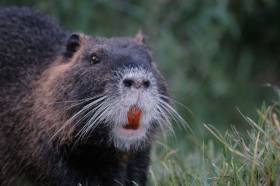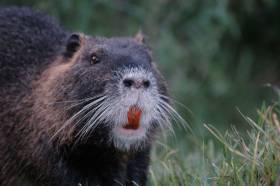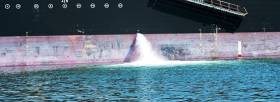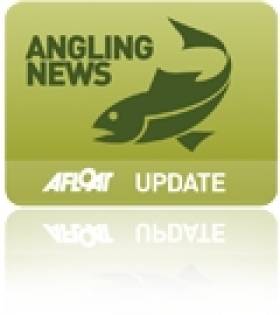Displaying items by tag: invasive species
Research led by Queen’s University Belfast has shown that invasive species, such as the grey squirrel, European rabbit and Japanese knotweed, have cost the UK economy over £5 billion over the past 40-50 years, making the cost one of the highest totals in Europe.
Invasive species, those introduced and spreading outside of their native range as a result of human activities, are a growing threat to environments worldwide.
Environmental impacts of invasive species, one of the main causes of biodiversity loss, are well-studied. However, few studies have summarised their economic impacts.
This study is the largest and most up-to-date combination of economic costs of biological invasions in the UK. The results have been published today (Thursday 29 July) in the journal NeoBiota.
The study was first authored by Dr Ross Cuthbert, Research Associate from the School of Biological Sciences at Queen’s University and Postdoctoral Research Fellow from GEOMAR Helmholtz Centre for Ocean Research in Kiel, Germany. It involved an international team of researchers that have built the first global database of invasion costs named InvaCost, led by a team at Paris-Saclay University.
Dr Cuthbert said: “We have found the majority of costs were caused by direct damages, such as reductions in agricultural productivity and infrastructure repair costs, whereas very little was spent on the actual management of invasive species, and especially prevention of future invasions.
“Worryingly, we also found that invasion costs are increasing rapidly over time and are likely to continue rising in future as more invasive species arrive in the UK. These costs are also severely underestimated, as very few of the known invasive species in the UK have reported economic costs (< 10%), indicating a lack of research effort and reporting of their detrimental impacts.”
To conduct their study, the researchers examined how costs in the UK were distributed across different invasive species, environments and cost types, and how they have changed through time.
They found that in the last 40-50 years, invasive species have cost the UK economy over £5 billion, with most of the cost due to invasive animals and plants, such as the European rabbit, Japanese knotweed and waterweeds, and predominantly through agricultural or property impacts.
For example, invasive rabbits cause severe damage to agricultural areas by overgrazing, which affects both the growth and yield of key crops, especially considering grasslands and cereals. Their burrowing can also impact the quality of pastures.
Japanese knotweed causes structural damage to property that is expensive to remediate and reduces house values substantially.
Invasive waterweeds can clog waterways, blocking access by watercraft, worsening flood risk and impeding recreational activities such as angling.
The researchers hope this study will raise awareness of the huge economic burden invasive species have on the UK economy for policy makers and society and will promote greater management spending to prevent their damage on different sectors of the economy and ecosystems.
Dr Cuthbert added: “Investing in better biosecurity to prevent invasive species from arriving in the first place could reduce future economic impacts and be much cheaper than future damages or long-term control.”
The research was funded by the French National Research Agency (ANR-14-CE02-0021), the Alexander von Humboldt Foundation, AXA Research Fund Chair of Invasion Biology and the BNP-Paribas Foundation Climate Initiative.
Anglers Alerted Over Non-Native Pacific Pink Salmon
Inland Fisheries Ireland (IFI) is appealing for the angling community and general public to report any sightings of Pacific pink salmon after a specimen was caught in Co Mayo this week.
Also known as ‘humpback’ salmon, pink salmon were very rare in Irish waters until 2017 and are believed to have originated from stocking programmes in Russia.
Scientists at IFI are concerned that if there are large numbers of the non-native species in Irish rivers, this may have negative impacts on Ireland’s salmon and trout populations in the future.
Dr Paddy Gargan with IFI says: “If Pacific pink salmon become established in Irish rivers, they will be competing with Irish salmon and trout for food and space.
“Pink salmon also display aggressive behaviour towards native fish and a large invasion of pink salmon could push out Atlantic salmon and trout from holding pools into smaller channels.”
IFI has published a guide on its website to help the public identify Pacific pink salmon, which have large oval black spots on their tails. Males also develop a pronounced ‘humpback’.
Appealing for help from the angling community and general public, Dr Gargan adds: “There is only limited information currently available to assess the threat from Pacific pink salmon, so we are asking the angling community and general public to report any sightings to Inland Fisheries Ireland by telephoning our 24 hour confidential hotline on 1890 34 74 24.”
The first reported catch of a Pacific pink salmon in Ireland this year was in the Ridge Pool at the Moy Fishery in Co Mayo on Sunday 27 June.
Anglers across the country are also being asked to report any further catches of Pacific pink salmon to IFI and to assist with research efforts by following these steps:
- Keep the Pacific pink salmon and do not release it back into the water, even in rivers that are only open for ‘catch and release’ angling.
- Record the date and location of capture, and the length and weight of the fish.
- Take a photograph of the fish and keep a copy of the image.
- Tag the fish and please report it to Inland Fisheries Ireland as soon as possible by telephoning 1890 34 74 24.
IFI will arrange collection of Pacific pink salmon catches for further analysis and will also promptly issue replacement tags to anglers.
Public Urged To Be On the Lookout for Invasive Blue Crab
Beach walkers have been urged to keep a lookout for invasive blue crab after a recent sighting in Dublin Bay.
As the Irish Examiner reports, the National Biodiversity Day Centre says a specimen was found on Dollymount Strand on 15 February, with a claw from the same species found on the same beach this past Tuesday (9 March).
It marks the first sighting of the crab, which is native marine wildlife on the US east coast, in Irish waters — though it has become established as an invasive species in the Mediterranean.
It’s as yet unknown whether the blue crab originated from the food trade, came as a stowaway in a ship’s hull or arrived by other means.
But the situation has prompted a call for vigilance by the public walking in coastal areas around Ireland — and for photographic evidence of any possible sighting.
The Irish Examiner has more on the story HERE.
Invasive Fish Species Chub Confirmed In Shannon Tributary
Invasive chub have been confirmed in the River Inny in Longford, according to Inland Fisheries Ireland (IFI).
A single fish was caught on rod and line at one of a number of spots where IFI staff recorded possible sightings following reports from members of the public.
Chub (Squalius cephalus) are non-native to Ireland, with the potential to compete with native species for food and space as well as be a carrier of fish diseases and parasites.
The River Inny — a tributary of the Shannon — is the only Irish river in which they have been recorded thus far, and removal operations between 2006 and 2010 were thought to have eradicated the species from the system.
It is not yet clear whether the current chub are linked to the original population or were more recently introduced.
However, the threat of chub spreading through the Shannon system “is of real and pending concern to the biodiversity of Ireland’s biggest catchment”, says the fisheries body.
IFI’s head of research Dr Cathal Gallagher explained: “Ireland’s rivers are ecologically important ecosystems, which support significant recreational fisheries for native and established fish species.
“Non-native fish species threaten these ecosystems and the game and coarse fisheries that they support — potentially in unforeseen ways — and are thus a cause for concern.”
IFI appeals to anglers to protect Ireland’s fisheries by not moving fish between watercourses for any reason and to submit any sightings directly to IFI or on the hotline at 1850 347424 or 1850 FISH24.
Inland Fisheries Ireland (IFI) has renewed its appeal to angling enthusiasts and the general public to be vigilant and report the presence of any Pacific pink salmon encountered in Irish river systems over the coming months.
In 2017, this non-native fish species unexpectedly appeared in unprecedented numbers in multiple river systems in the south-west, west and north-west of the country.
As pink salmon predominantly have a two-year lifecycle, there is potential for the species to reappear in Irish rivers again this year and every second, so-called ‘odd’ year thereafter.
However, they can also turn up in ‘even’ years and a single specimen was recorded in the River Suir in 2018.
Also known as humpback salmon, pink salmon are a migratory species, native to river systems in the northern Pacific Ocean and nearby regions of the Bering Sea and Arctic Ocean.
The species also has established populations in rivers in northernmost Norway and in the far northwest of Russia, originating from stocking programmes undertaken in this part of Russia since the 1950s until 2001.
Although a single specimen was first recorded in Ireland in 1973, they were very rare in Irish waters until 2017.
In the past week, pink salmon have been reported returning to rivers further south in Norway than anticipated which increases the likelihood of their reappearance in Irish rivers this year.
“The potential presence of pink salmon in Irish rivers again is of ongoing concern to Inland Fisheries Ireland as its presence in large numbers may negatively impact some of Ireland’s native species such as Atlantic salmon and sea trout as well as estuarine and coastal marine fish species and their associated ecosystems,” says Dr Cathal Gallagher, IFI’s head of R&D.
“Despite only very limited information being currently available to assess such threats, the climatic and environmental conditions in Ireland are considered quite amenable to facilitate the establishment of Pacific pink salmon populations in Irish river systems.”
IFI has developed an identification guide (2.31 MB PDF) to help anglers and the general public identify pink salmon.
Anglers are asked to report catches of pink salmon to IFI’s 24 hour confidential hotline number at 1890 34 74 24 or 1890 FISH 24. As these fish die after spawning, some dead specimens could also be encountered along Irish rivers.
Anyone who catches a pink salmon is asked to:
- Take a photograph of the fish
- Tag the fish and present it to IFI and a new tag will be issued to replace the tag used
- Record the date and location of capture, and the length and weight of the fish
- Keep the fish and do not release it back into the water (even in rivers only open for catch and release angling)
IFI will then arrange collection of the fish for further examination. This will help establish the abundance and extent of distribution of the species in Irish waters.
Appeal For Sightings Of Invasive Coypu On Royal Canal In Dublin
Waterways Ireland advises all users of sightings on the Royal Canal at Ashtown of a large invasive rodent species that is highly damaging to river, lake and canal banks.
As previously reported on Afloat.ie, the coypu — also known as the nutria in the United States — is regarded as a destructive invasive species and pest, posing a threat to agriculture, the stability of river banks and even coastal defences.
The coypu is an EU-regulated species of concern with trade, transport and reproduction restrictions in place (No.1143/2014).
The large river rats can also carry a number of serious diseases communicable to humans and domestic animals.
Waterways Ireland says coypu eradication programmes can cost up to several millions of euro and are not always successful.
Most recently there were sightings of the rodents in Cork city two years ago, after a number were trapped by the National Parks and Wildlife Service (NPWS) in a tributary of the River Lee.
But their presence across the country in the capital raises concerns about their further spread throughout Ireland’s inland waterways.
Waterways Ireland has provided a checklist for how to spot a coypu, which are often confused with common otters:
- Large semi-aquatic rodent up to 1 meter in head to tail length. Features same in juveniles.
- It can weigh 5-9kg.
- It has webbed hind feet.
- Dark fur often with lighter ends and has a white muzzle.
- Has long cylindrical tail (not fur tail like otter) and small slightly protruding ears.
- Distinctive features are large bright orange-yellow incisor (front) teeth usually visible.
- Coypu are generally found near permanent water.
Do not attempt to engage, trap or harm these animals.
Waterways Ireland appeals for the public keep a lookout along the waterways and especially along the Royal Canal at Ashtown, and report sightings (with photos is possible) to any of the following:
- Waterways Ireland Environment Section 061-922141
- NPWS at [email protected] or your local NPWS ranger with details of location/date and a photo if available
- [email protected]
- records.biodiversityireland.ie
For more information visit species.biodiversityireland.ie.
Public Urged To Report Coypu Sightings In Cork
#MarineWildlife - Cork residents near the River Lee are urged to be report any sightings of coypu after one of the large rodents was seen in Cork city last week.
The invasive species was released within the last two years in the Curraheen River, a tributary of the Lee, with the National Parks and Wildlife Service (NPWS) trapping 10 of the large river rats since then, according to the Irish Examiner.
But the NPWS now seeks the public’s help in identifying how far beyond the Curraheen they might have spread, with possible sightings on the Cork-Bandon road, at Monkstown on Cork Harbour and in streams north of the city.
The situation is a far cry from two years ago, when fears of a coypu invasion of Ireland’s inland waterways were dismissed upon the news of a single three-foot rodent found in a Tipperary stream, as previously reported on Afloat.ie.
Also known as nutria in the United States, the rodents are regarded as a destructive invasive species and pest, posing a threat to the stability of river banks and even coastal defences.
The Irish Examiner has more on the story HERE.
Social Media Post Fuels Dispute Between Anglers Over Non-Native Species In Western Lakes
#Angling - Plans to introduce non-native fish species into Irish lakes have been alleged by Irish angling enthusiasts, as the Mayo News reported recently.
A social media post via the Irish Pike Society, which has since been removed, claimed that fishermen from the UK and Ireland were planning this month to introduce various non-native fish such as catfish and barbel into designated brown trout fisheries that include Lough Mask and Lough Conn.
Inland Fisheries Ireland confirmed they were aware of the claims and were monitoring the situation.
According to the Connacht Tribune, the allegation is the latest incident in an ongoing dispute between anglers who want to keep western loughs free of predatory fish like pike, and others who feel undue preference is given to salmon and trout.
Government Delays For Five Years Signing Up To United Nations Treaty For Marine Environment Protection – PODCAST
Five years ago the Department of Transport told the United Nations agency dealing with safety at sea and the marine environment that it was preparing to ratify a treaty drawn up by the UN intended to control the spread of invasive marine species which could cause damage in Irish waters, possibly wiping out native marine species and causing damage to the marine environment generally.
Five years later, while 51 nations around the world have signed the Ballast Water Management Convention drawn up by the International Maritime Organisation, Ireland still hasn’t done so, despite a request from the Secretary General of the Organisation.
The treaty is designed to counter the threat to marine ecosystems caused by potentially invasive species carried across the oceans of the world in ships’ ballast water. Ballast water is essential to the safe and efficient operation of modern shipping, providing balance and stability to unladen and partly laden ships. Because shipping transports up to 90 per cent of the world’s traded commodities, it is reckoned to transfer up to 5 billion tonnes of ballast water around ports of the world every year and that is claimed by scientists to be the main cause of introducing non-native species from one country to another.
When Peru, this month, became the 51st State to accede to the Treaty to try to control this problem, I asked the International Maritime Organisation if Ireland had ratified…
“Not yet” I was told from IMO Headquarters in London, with the additional quote from their spokesperson… “but it is apparently intending to … Well that is what Ireland said in 2011” and they sent me a copy of Marine Notice No.47 of 2011 from the Department of Transport which stated that “Ireland’s maritime administration is at present preparing the legislation that is required and intends to ratify the Convention when this process is complete…”
Five years later, the IMO suggested to me that it might be worth asking why Ireland had not signed… I did and the Department told me…that “provision to give effect to the Convention was made in the Sea Pollution Miscellaneous Provisions Act of 2006. Now that’s ten years ago, but it seems a Statutory Instrument has been drafted by the Department to give effect to the Convention in Irish law. However, subject to some legal clarifications the Department expects that the Order will be enacted only …” shortly after the Convention comes into force…”
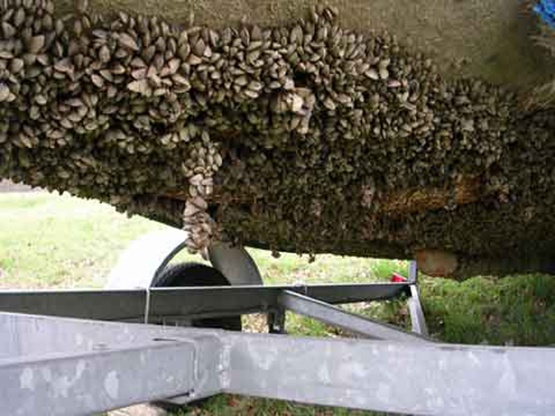
Zebra mussels on the hull of a boat
Thereby hangs the rub…This treaty has actually been hanging around since 2004, that’s 12 years ago, even as the problems of invasive species increased with specific threats identified in Ireland by Government task forces, to freshwater river systems, lakes and coastal areas. To come into effect it needs a minimum of 30 States to approve it which would represent 35 per cent of world merchant shipping tonnage. 51 States have done so but they represent only 44.87 per cent of tonnage. Ireland’s access would only add .02 per cent tonnage, but the Secretary General of the IMO has appealed to every nation to support the Convention… so why is Ireland delaying, saying that it won’t sign until the Convention comes into force… in other words waiting for other nations to support it while Ireland won’t?
Senator Grace O’Sullivan is the Green Party’s spokesperson on the environment and says Ireland could push the treaty along if the Government would sign it, while Richie Flynn, Executive of IFA Aquaculture on behalf of fish farmers, isn’t surprised by the failure to sign, but it doesn’t please him.
Hear their views and the Podcast above.
Lanesborough Asian Clam Report Says Removal 'Not Feasible'
#Angling - Inland Fisheries Ireland (IFI) has published its report on the Asian clam survey at Lanesborough, Co Longford and the surrounding area, which has found that complete removal of the invasive species "is not feasible".
As previously reported on Afloat.ie, IFI said it was working closely with all relevant agencies as well as local community and angling groups to re-open the popular fishery after last month's invasive species scare.
All stakeholders have now been briefed with IFI's report and recommendations and management actions will be considered over the coming weeks.
IFI says an "enormous amount of work has taken place over a short period of time.
"It is clear from the findings of the survey that the population of Asian clam has already reached a stage where complete removal is not feasible."
It's expected that disinfection kits will be commissioned in the coming week to halt any further spread of Asian clam from the Lanesborough fishery.
Fishing is then set to resume thereafter, but anglers are reminded that fishing will remain closed until an official announcement from IFI.
The full report on the Lanesbourough Asian clam situation is available as a PDF to read or to download HERE.





























